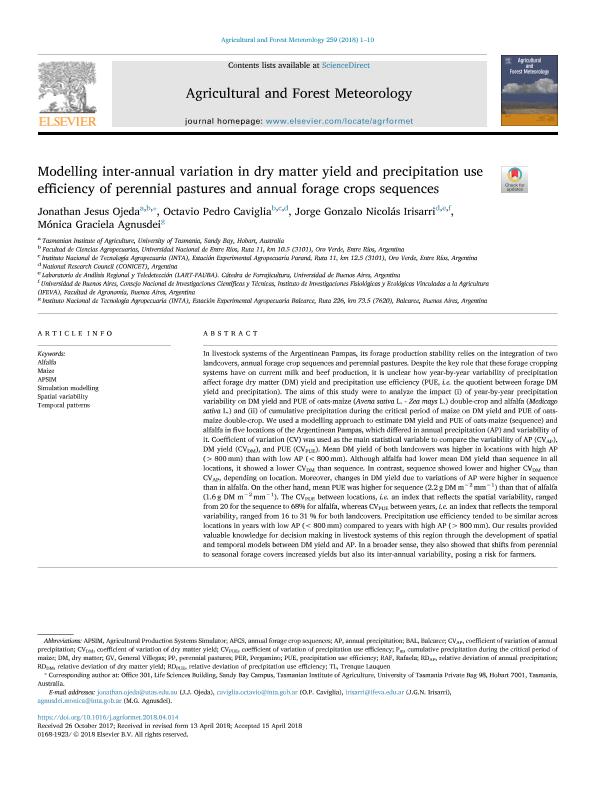Artículo
Modelling inter-annual variation in dry matter yield and precipitation use efficiency of perennial pastures and annual forage crops sequences
Ojeda, Jonathan Jesus ; Caviglia, Octavio Pedro
; Caviglia, Octavio Pedro ; Irisarri, Jorge Gonzalo Nicolás
; Irisarri, Jorge Gonzalo Nicolás ; Agnusdei, Mónica Graciela
; Agnusdei, Mónica Graciela
 ; Caviglia, Octavio Pedro
; Caviglia, Octavio Pedro ; Irisarri, Jorge Gonzalo Nicolás
; Irisarri, Jorge Gonzalo Nicolás ; Agnusdei, Mónica Graciela
; Agnusdei, Mónica Graciela
Fecha de publicación:
09/2018
Editorial:
Elsevier Science
Revista:
Agricultural And Forest Meteorology
ISSN:
0168-1923
Idioma:
Inglés
Tipo de recurso:
Artículo publicado
Clasificación temática:
Resumen
In livestock systems of the Argentinean Pampas, its forage production stability relies on the integration of two landcovers, annual forage crop sequences and perennial pastures. Despite the key role that these forage cropping systems have on current milk and beef production, it is unclear how year-by-year variability of precipitation affect forage dry matter (DM) yield and precipitation use efficiency (PUE, i.e. the quotient between forage DM yield and precipitation). The aims of this study were to analyze the impact (i) of year-by-year precipitation variability on DM yield and PUE of oats-maize (Avena sativa L. - Zea mays L.) double-crop and alfalfa (Medicago sativa L.) and (ii) of cumulative precipitation during the critical period of maize on DM yield and PUE of oats-maize double-crop. We used a modelling approach to estimate DM yield and PUE of oats-maize (sequence) and alfalfa in five locations of the Argentinean Pampas, which differed in annual precipitation (AP) and variability of it. Coefficient of variation (CV) was used as the main statistical variable to compare the variability of AP (CVAP), DM yield (CVDM), and PUE (CVPUE). Mean DM yield of both landcovers was higher in locations with high AP (>800 mm) than with low AP (<800 mm). Although alfalfa had lower mean DM yield than sequence in all locations, it showed a lower CVDM than sequence. In contrast, sequence showed lower and higher CVDM than CVAP, depending on location. Moreover, changes in DM yield due to variations of AP were higher in sequence than in alfalfa. On the other hand, mean PUE was higher for sequence (2.2 g DM m−2 mm−1) than that of alfalfa (1.6 g DM m−2 mm−1). The CVPUE between locations, i.e. an index that reflects the spatial variability, ranged from 20 for the sequence to 68% for alfalfa, whereas CVPUE between years, i.e. an index that reflects the temporal variability, ranged from 16 to 31 % for both landcovers. Precipitation use efficiency tended to be similar across locations in years with low AP (<800 mm) compared to years with high AP (>800 mm). Our results provided valuable knowledge for decision making in livestock systems of this region through the development of spatial and temporal models between DM yield and AP. In a broader sense, they also showed that shifts from perennial to seasonal forage covers increased yields but also its inter-annual variability, posing a risk for farmers.
Palabras clave:
ALFALFA
,
APSIM
,
MAIZE
,
SIMULATION MODELLING
,
SPATIAL VARIABILITY
,
TEMPORAL PATTERNS
Archivos asociados
Licencia
Identificadores
Colecciones
Articulos(IFEVA)
Articulos de INST.D/INV.FISIOLOGICAS Y ECO.VINCULADAS A L/AGRIC
Articulos de INST.D/INV.FISIOLOGICAS Y ECO.VINCULADAS A L/AGRIC
Articulos(SEDE CENTRAL)
Articulos de SEDE CENTRAL
Articulos de SEDE CENTRAL
Citación
Ojeda, Jonathan Jesus; Caviglia, Octavio Pedro; Irisarri, Jorge Gonzalo Nicolás; Agnusdei, Mónica Graciela; Modelling inter-annual variation in dry matter yield and precipitation use efficiency of perennial pastures and annual forage crops sequences; Elsevier Science; Agricultural And Forest Meteorology; 259; 9-2018; 1-10
Compartir
Altmétricas



